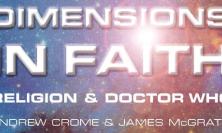
The presence of Jesuit characters in science fiction novels is somewhat curious but rarely discussed. Writing in the Spanish Jesuit journal, Razón y fe, Agustín Udías Vallina SJ surveys ten of those novels to show the great variety of themes and perspectives that their stories cover. What new territories do these Jesuit characters allow the authors to cover, and what does this tell us about the popular perception of the Society?
Science fiction is a literary genre that normally deals with situations resulting from projected advances in science and technology in a distant future. It is difficult to define the genre precisely, and within it one finds stories on quite different themes: for example, the Earth in the distant future, transformed by scientific progress; or voyages in space to distant planets inhabited by exotic, intelligent beings who interact with humans. Within science fiction there are many subgenres and types, but in all of them science and technology, real or invented, play a key role. In the novels one might find other worlds, aliens, mutants and intelligent robots, together with not-always-realistic speculations about scientific and technological advances and human reactions to them.
Curiously, in some of these novels we meet Jesuit characters, sometimes in the lead role, who are generally scientists. This responds in some way to a popular identification of scientific clergymen with Jesuits, and it allows the authors to touch on themes related to religion. In some of these books, generally situated in the distant future, Jesuits take part in space voyages, leading Anna Tschetter to propose a subgenre of ‘Jesuits in Space’ for these novels: ‘One of my favourite sub-genres of sci-fi (or perhaps a sub-sub-genre) is what my family and some friends like to call “Jesuits in Space”. It’s a small genre; not many people outside of the Christian publishing world write a lot about missionaries and evangelism’.[i] Grayson Clary states that for authors of science fiction, Jesuits turn out to be good leading characters as mystical adventurers and scientists, and, in addition, he thinks anything can be believed about them because they are so rare![ii]
Guy Consolmagno SJ, current director of the Vatican Observatory, takes a more critical position on such novels. In general, he says, it is difficult to enjoy many of these stories because they contain so many mistakes, especially in their philosophy, history or science, often due to the carelessness, prejudice or ignorance of the author, when they could easily have been presented correctly. Consolmagno thinks that one could overlook some mistakes in scientific principles, but one cannot suspend judgement on how a novel shows people acting, Jesuits or not. Because of this, he thinks it is more difficult to believe what the author is trying to say in most of these novels.[iii]
Even so, despite Consolmagno’s criticism, the presence of Jesuits in some science fiction stories continues to be an interesting topic and merits further reflection. There is no doubt that this presence reflects, first of all, some sort of implicit recognition of the scientific tradition amongst Jesuits. No group in the Church has made as much of a contribution to the sciences, at not just an individual but also an institutional level, as the Jesuits. The educational institutions that constituted the main work of the Society from its early days, where the sciences held a significant place, are a demonstration of this presence. In the modern era, the Jesuits have founded and directed a network of universities with scientific departments, as well as astronomical and geophysical observatories, in which significant contributions were, and continue to be, made to these sciences.[iv]
The novels
One of the best known members of the sub-genre of science fiction novels with Jesuit heroes is without doubt Mary Doria Russell’s story in two parts: The Sparrow (1996) and Children of God (1998). The first part recounts how the Jesuits, after detecting a musical signal coming from a distant planet, are mandated by their Superior General to send an expedition to space in which four Jesuits and four lay people (including two women) will take part, under the direction of D. W. Yarbrough, who had been a captain in the US Marines before becoming a Jesuit. They arrive on the planet Rakhat and find two intelligent species living there – Jana’ata and Runa, dominant and dominated, respectively – and the team experience many hardships in which three of them die. The main character is Emilio Sandoz, a Puerto Rican Jesuit philologist, who will be the only one to return to Earth. The second part tells the story of the only survivor of the group to remain on the planet, living with the Runa, and of Sandoz who, because he cannot get over his terrible experiences on Rakhat (where the Jana’ata had turned him into a sexual slave), eventually leaves the Society. However, Sandoz is obliged to return to Rakhat on a second journey, in which two new Jesuits take part, with some participation from a mafia group with commercial interests. Sandoz finds that in his absence great changes have occurred in the relationship between the two species of the planet, with the revolt of the Runa against the Jana’ata, and finally he returns to Earth.
In James Blish’s novel, A Case of Conscience (1958), the lead character is Ramón Ruiz-Sánchez, a Peruvian Jesuit biologist, who finds himself working with a group of scientists on Lithia, an exoplanet inhabited by a species of giant, intelligent reptile who have developed a curious and happy civilisation. The key point is that the Lithians are not aware of good and evil, acting always in accord with reason, incapable of all types of faith and religious feeling. This worries Fr Ruiz-Sánchez and creates for him the title’s ‘case of conscience’ because of the consequences this could carry, leading him to ask whether these beings were created by the devil. Before returning to Earth, he receives the gift of a fertilised egg of a Lithian to take with him. The second part of the novel is about the problems that the Lithian on Earth creates for the Jesuit when it is an adult, by becoming very popular and spreading its radical, rationalist ideas, before returning to its planet. This all leads to a surprising conclusion with the command of the pope who, suspecting Ruiz of Manicheanism, sends him to exorcise the planet. This, in turn, creates a new case of conscience because of the possible consequences. Finally, the exorcism unexpectedly results in the destruction of the planet Lithia.
Two works introduce the topic of the Star of Bethlehem. Arthur C. Clarke in the short story, The Star (1955), recounts in the first person the reflections of a Jesuit astrophysicist (whose name does not appear) in charge of an expedition to the Phoenix Nebula, 3000 light years from Earth, to study the remains of a supernova. There they discover, on an isolated planet that has survived the explosion of the star, a vault in which the last inhabitants had left information about their advanced and splendid civilisation, which had been destroyed. The Jesuit realises that this supernova was the Star of Bethlehem, and asks how what shone over Bethlehem to announce the birth of Christ could also be what destroyed such a marvellous civilisation.
In The Magi (2009) by Damien Broderick, the Jesuits, in a far distant future, have been expelled from the Earth and the last 400 live exiled in a spaceship lost in space. Raphael Silverman, a Jesuit physicist from a Jewish family, accompanied by three other Jesuits, goes down in a small ship to an uninhabited planet, where they encounter an abandoned city. After a series of adventures, Silverman discovers a message left for them, saying that all the inhabitants of the city had abandoned it in spaceships when they observed the Star of Bethlehem, because, interpreting its meaning, they had all left in search of the Saviour whom the Star announced.
A different theme is that of Hilbert Schenck’s book, The Theology of Water (1982). Thomas Feeney, a Jesuit geophysicist who had already taken part in other space journeys and whom the press call ‘God’s astronaut’, takes part in a NASA-sponsored journey to Titan, a satellite of Saturn. Even though they do not find life – the principal goal of the journey – they discover that the water there has very different properties from those that it has on Earth. However, the longer the travellers are in contact with the environment of the satellite, the more its properties change to resemble those on Earth, as if the water were adapted to humans. So, it would seem that the very properties of water are shaped for the use of humans and that creation is directed to that end.
In Dante Dreams (1998) by Stephen Baxter, the Jesuit is a woman, Eva Himmelfarb, an expert in organic computing and a member of the first generation of female Catholic priests. Eva commits suicide because of her work and, as a result, the Vatican establishes an investigation into her motives. An agnostic journalist and a member of the Pontifical Academy of Sciences take part in the interrogation of a virtual representation of the dead woman. The interrogation (which includes many quotations from the Divine Comedy), linked to the results of the strange biological work that she had completed, ends with the cleric giving absolution to the virtual Eva.
Even stranger is the story ‘The Priest’s tale: The Man who Cried God’ (1989), part of Dan Simmons’ work, Hyperion. The history is situated in a future in which humanity has spread throughout the whole galaxy under a central government called ‘Hegemony’. Paul Duré is a Jesuit archaeologist, ethnologist and theologian. After some controversial archaeological investigations on the planet Armaghast, he decides to travel to Hyperion’ a distant world where the strange cult of Shrike began, aiming to study a little-known human group, the Bikura, which was the origin of said cult. A young priest (it is not said that he is a Jesuit), Lenar Hoyt, goes with him to the planet, and returns a few years later to confirm Duré’s death and find his diary, the text of which forms the main part of the novel. The diary describes the strange successes of Duré with the Bikura, his discovery of an ancient shrine, the secret of the inhabitants (‘cruciforms’), and the remains of a human expedition infected by a parasitic worm that kept them alive and which finally leads him, and later also Hoyt, to their deaths.
The short story, The Word to Space by Winston P. Sanders, relates how James Moriarty, a Jesuit geologist from Loyola University, Los Angeles, tries to answer some messages that reach Earth from Akron, a planet 25 light years distant. The planet is ruled by a totalitarian theocratic system and the messages consist of religious propaganda used by sects on Earth. The whole story is a conversation in which Moriarty tries to convince the person receiving the messages on Earth to let him reply and try to reform the planet in its religious beliefs and behaviour. 75 years later, news arrives that they have accepted Moriarty’s proposals, to the benefit of the planet, including the separation of the religious and the civil powers.
A fantastic novel somewhere between satire and the absurd is James Morrow’s Towing Jehovah (1994). The plot introduces the idea of the death of God whose corpse, a typical figure of an old man but two miles in length, is floating at the Equator and must be towed to the North Pole, where the angels have prepared a tomb in the ice. One of the main characters is the Jesuit, Thomas Wickliff Ockham (named in memory of the medieval nominalist philosopher), a particle physicist at Fordham University and author of the books Mechanics of Grace and Superstrings of Salvation, which link physics and religion. Ockham is given the task by Pope Innocent XIV of towing the body of God, which will be loaded on a petrol tanker whose captain has been commanded to do this by an angel. During the journey, there are many strange occurrences – hurricanes, apparitions of unknown islands, the intervention of angels who keep dying and aerial attacks by an aircraft carrier from the Second World War – until they finally deposit the body in a vault of ice. By the end of the story, Ockham believes he has discovered a response to the death of God.
The Jesuits, the Catholic Church and Christianity
What motivated all of these authors to use Jesuits? What image of Jesuits do these stories offer? How does that image correspond to what one might expect of Jesuits? And what ideas have the inclusion of Jesuits allowed the authors to introduce that other novels of this genre do not normally cover?
As mentioned already, the majority of the Jesuit characters are scientists, which in some way explains why authors have chosen Jesuit characters, more readily associated with science as they are, rather than Dominicans, Franciscans or any other religious of the Catholic Church. From this flows the question of why members of the Church are used as characters at all in these novels, and what image these characters project of the Church and of Christianity in general.
It is difficult to arrive at a single image of the Jesuits from these novels, since the characters are very different and the situations very diverse. In general, there is a positive characterisation, but no unifying, clear expression of Jesuit spirituality. Without the latter, the characters represent little more than what the authors think Jesuits are, sometimes resulting in a distorted image of what a Jesuit is, especially since they are placed in strange and complex situations of space travel and contact with aliens.
Even in the two books by Russell, in which the greatest number of Jesuits appear, from Father General Vincenzo Giuliani to Brother Edward Behr, very different images are given. The principal character, Sandoz, is a figure tormented by the experience of his captivity and sexual enslavement, which he does not succeed in overcoming, and he ends up leaving the Jesuits. Amongst the other Jesuits there is a great variety of attitudes, which have to be read in the broad and complex context of the two volumes. The novelist has made a great effort to show the perspectives of the different Jesuit characters, all of them dedicated to this spatial venture and to its contact with the two sorts of inhabitants of the planet, motivated, as she insists, by the Greater Glory of God.
Another example is Fr Ruiz-Sánchez in Blish’s novel, who finds himself confronted by a continuing problem of conscience concerning the behaviour of the Lithians: whether their existence constitutes a negation of the necessity of God, and if they are created by the bad spirit. The solution of performing an exorcism, proposed by the pope, creates a new case of conscience for him, because if it were to happen, the humans working on the planet would also die.
The figure of Teilhard de Chardin, who would have been good inspiration for a futuristic vision of humankind, is, however, not used in any of these novels. Only in Simmons’ work does a Jesuit protagonist appear as a follower of ‘St Teilhard’, who, it would seem, had already been canonised. Also, in this book Christianity is reduced to a small sect, of which the Jesuits are a group, active in a totally secularised humanity. On the other hand, the Vatican and the pope, and their relationship with the Jesuits, appear in various novels as an attractive literary device.
Conclusion
In spite of the limitations of the genre, and the scarce knowledge that the authors generally have about the Jesuits, the very fact that they have been chosen as characters in these novels is still interesting. Generally, the stories are almost always about Jesuit scientists and, as we have seen, these are treated with a certain sympathy. Further, as has already been acknowledged, there is a recognition of the traditional special relationship of the Jesuits and the pursuit of science; and the additional plot devices that come with them being members of a religious order: conscience, and relationships with the faith and the structure of the Church. In the case of contact with extra-terrestrials in other worlds the problem is raised of the spread of religious thought beyond humankind and its impact on other intelligent beings. The presence of the Jesuits serves, therefore, to introduce issues and problems which would not otherwise have occurred in this type of novel.
Agustín Udías Vallina SJ is Emeritus Professor of Geophysics at Universidad Complutense (Madrid).
This text is adapted from an article first published in Razón y fe, translated by Dushan Croos SJ and with thanks to Jack Mahoney SJ.
Bibliography
Stephen Baxter, ‘Dante dreams’, in Phase Space (London: Harper-Collins, 2003), pp. 86-103.
James Blish, A case of conscience (New York: Ballantine, 1958).
Damien Broderick. ‘The Magi’, in Alan Ryan (ed.) Perpetual Light (New York: Warner Books, 1982), pp. 302-344.
Arthur C. Clarke. ‘The star’, in Id., The nine billion names of God: The best short stories of Arthur C. Clarke (New York: Signet, 1974), pp. 235-240.
James Morrow, Towing Jehovah (New York: Harcourt Blaze, 1994).
Mary D. Russell, The Sparrow (London: Black Swan, 1997).
Mary D. Russell, Children of God (New York: Fawcett Books, 1998).
Winston P. Sanders, ‘The word to space’, in Mayo Mohs (ed.), Other Worlds, Other Gods (London: New English Library, 1976).
Hilbert Schenck. ‘The theology of water’, in Alan Ryan (ed.) Perpetual Light (New York: Warner Books, 1982), pp. 170-188.
Dan Simmons, ‘The priest’s tale: the man who cried God’, in Hyperion (London: Orion Publishing, 2004), pp. 23-98.
[i] http//womenwriteaboutcomics.com/2015/08/04/Jesuits-in-space-or-a sci-fic-sub-genre-examining-religions- failings/
[ii] G. Clary, ‘Why Sci-Fi has so Many Catholics’, www.theatlantic.com/technology/archive/2015/11/why-are-there-so-many-cat.../
[iii] G. Consolmagno SJ, ‘A Jesuit astronomer’s guide to avoiding awful science fiction’, http://www.uscatholic.org/articles/201503/jesuit-astronomer%E2%80%99s-guide-avoiding-awful-science-fiction-29906
[iv] Cf. A. Udías Vallina, Los jesuitas y la ciencia. Una tradición en la Iglesia (Bilbao: Mensajero, 2014); Agustín Udías, Jesuit Contribution to Science: A History (Springer, 2015 edition).





